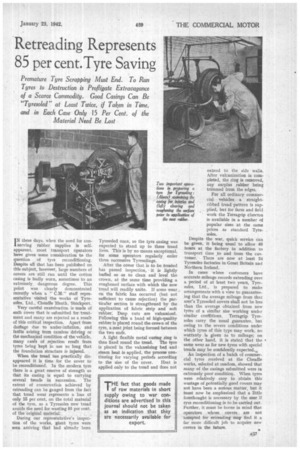Retreading Represents 85 per cent.Tyre Saving
Page 33

If you've noticed an error in this article please click here to report it so we can fix it.
I N these days, when the need for con serving rubber supplies is selfapparent, most transport operators have given some consideration to the question of tyre reconditioning. Despite all that has been published on this subject, however, large numbers of covers are still run until the cotton casing is badly worn, sometimes to an extremely dangerous degree. This point was clearly demonstrated recently when a " C.M." staff representative visited the works of Tyresoles, Ltd., Cheadle Heath. Stockport.
Very careful examination is made of each cover that is submitted for treatment and many are rejected as a result of this critical inspection. Apart from danlage due to under-inflation, and faults arising from careless driving or the mechanical condition of the vehicle, many cases of rejection result from tyres being kept in use so long that the foundation structure is injured.
When the tread has practically disappeared it is time for the cover to be reconditioned. In the modern tyre there is a great reserve of strength so that its casing is equal to carrying several treads in succession. The extent of conservation achieved by retreading can be gauged from the fact that tread wear represents a loss of only 15 per cent, on the total material of the tyre, so a Tyresoles new tread avoids the need for wasting 85 per cent of the original material.
During our representative's inspection of the works, giant tyres were seen arriving that had already been Tyresoled once, so the tyre casing was expected to stand up to three tread lives. This is by no means exceptional, for some operators regularly order three successive Tyresolings.
After the cover that is to be treated has passed inspection, it is lightly buffed so as to clean and level the crown, at the same time providing a roughened surface with which the new tread will readily unite. If some wear on the fabric has occurred (but not sufficient to cause rejection) the particular section is strengthened by the application of fabric strip and soft rubber. Deep cuts are vulcanized. Following this a band of high-quality rubber is placed round the crown of the tyre, a neat joint being formed between the two ends.
A light flexible metal curing ring is then fixed round the tread. The tyre is placed in the vulcanizing bed and steam heat is applied, the process continuing for varying periods according to the size of the cover. Heat is applied only to the tread and does not extend to the side walls. Alter vulcanization is completed, the ring is removed, any surplus rubber being trimmed from the edges.
For all ordinary commer cial vehicles a straightribbed tread pattern is supplied, but for farm and field work the Terragrip chevron is available in a number of popular sizes at the same prices as standard Tyresoles.
Despite the war, quick service can be given, it being usual to allow 48 hours at the factory in addition to transport time to and from the cuctomer. There are now at least 24 Tyresoles factories in Great Britain and Northern Ireland.
In cases where customers have accurate mileage records extending over a period of at least two years, Tyresoles, Ltd., is prepared to make arrangements with a view to guaranteeing that the average mileage from that user's Tyresoled covers shall not be less than the average obtained from new tyres of a similar size working under
• similar contlitions. Terragrip Tyresoles carry the usual guarantee, but owing to the severe conditions under which tyres of this type may work, no warranty is given as to mileage; on the other hand, it is stated that the same wear as for new tyres with special treads may be confidently expected„
An inspection of a batch of commer cial tyres received at the Cheadle works, selected at random, showed that many of the casings submitted were in extremely poor condition. When tyres were relatively easy to obtain this wastage of potentially good covers may not have been a serious matter, but it tnust now be emphasized that a little forethought is necessary by the user if tyre reconditioning is to be carried out. Further, it must be borne in mind that operators whose covers are not accepted for retreading may find it a far more difficult job to acquire new covers in the future.
























































